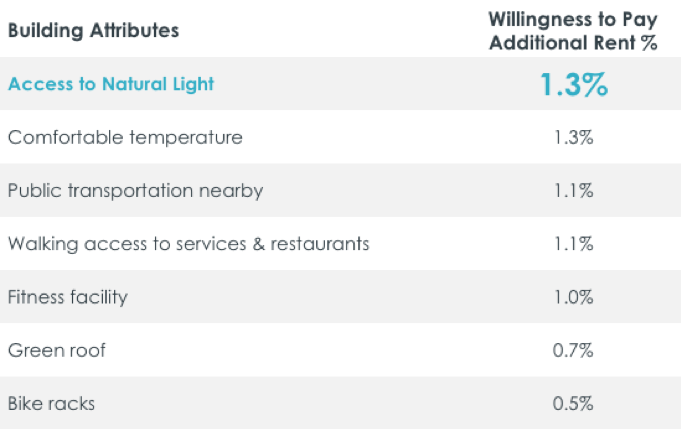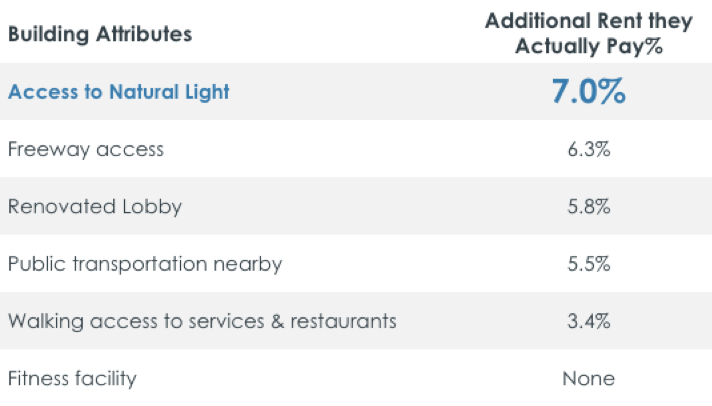Everyone knows that everyone loves natural light. Modern building design has been driven by occupants’ demand for open floorplans, tall ceilings and floor-to-ceiling glass. The proverbial “corner office” is the best spot because it has the most windows. And a recent study published in Harvard Business Review confirms that daylight and views are employees’ top office amenity over fitness centers, kitchens/cafes, standing desks and outdoor space.
But now we can quantify the benefits that natural light and views have for health and productivity outcomes, as well as business profits and real estate returns.
Daylight and Real Estate Value
If daylight and views are the top office amenity for employees, will tenants actually pay for it? A pair of studies funded by CBRE’s Green Research Challenge sought to answer this very question. The first study surveyed 708 organizational leaders and office managers in 329 buildings across 17 markets[1]. They asked respondents how much more they would be willing to pay in rent for different features, and natural light came out on top:

Then, when the researchers examined 2,246 leases in 197 office buildings across 20 markets, they found the correlation was even stronger than people’s stated willingness to pay[2]:

Natural light is the highest value building feature. Tenants say they are willing to pay up to 1.3% higher rent for a space with floor to ceiling glass. In reality they pay even more – 7% higher rent.
Health Benefits of Daylight
Employees are asking for daylight, and employers are paying for it, because it improves people’s lives. Daylight and views have a range of health and productivity benefits:
- 46 mins more sleep[3]. Daylight affects our circadian rhythm, or “body clock” that influences many of our physiological processes. Office workers without windows get less sleep, have poorer sleep quality and increased sleep disturbances than workers with significant daylight exposure. Poor sleep has a direct link to decreased performance, increased fatigue and risk of injury.
- 5% fewer sick days[4]. Daylight increases stress resistance, and reduces eye strain and headaches. A study of 175 office workers found that employees with access to high quality views and natural daylight take less sick time.
- 15% more time on work-related tasks[5]. A study of 70 windowed vs 50 non-windowed offices in a software development company in New York found that people with windows and views spent more time in their office actively working.
Moreover, new research from Alan Hedge of Cornell University found that people working in offices with dynamic glass, which changes tint in order to optimize the daylight coming into a space and eliminate the need for shades, experience[6]:
- 51% reduced eyestrain[7]
- 63% fewer headaches
- 56% less drowsiness
These symptoms are the core of computer vision syndrome, which affects 50-90% of computer users and results in a 2.5% productivity loss.
Case Study: Streaming Media Company

View Inc. recently installed dynamic glass in buildings 3 and 4 of a streaming media company’s headquarters in California. The original two buildings experienced glare 27% of the day, and indirect glare almost all the time, due to the full glass facade. Blackout shades were installed to address the glare, sacrificing the views of redwood trees and the Los Gatos mountains. The next two identical buildings were constructed with dynamic glass, but were identical in every other way. A survey of 250 employees working on the campus found that employees had 30% higher productivity with views of the outdoors compared to shades, and identified proximity to windows as the #1 most desirable workspace location.
[1] Spenser Robinson; Robert Simons; Eunkyu Lee; and Andrew Kern. “Demand for Green Buildings: Office Tenants’ Stated Willingness-to-Pay for Green Features.” Journal of Real Estate Research (2016). Funded by CBRE’s Real Green Real Estate Challenge
[2] Spenser Robinson, Robert Simons and Eunkyu Lee. “Which Green Office Building Features Do Tenants Pay for? A Study of Observed
Rental Effects.” Journal of Real Estate Research (2017). Funded by CBRE’s Real Green Real Estate Challenge
[3] Boubekri et al. ” Impact of Windows and Daylight Exposure on Overall Health and Sleep Quality of Office Workers: A Case-Control Pilot Study” 2014. https://www.ncbi.nlm.nih.gov/pmc/articles/PMC4031400/
[4] Elzeyadi et al. ” Daylighting-Bias and Biophilia: Quantifying the Impact of Daylighting on Occupant Health” 2011. https://www.usgbc.org/sites/default/files/OR10_Daylighting%20Bias%20and%20Biophilia.pdf
[5] Figueiro et al. ” Daylight and Productivity- A Possible Link to Circadian Regulation ” 2014. www.lrc.rpi.edu/programs/lightHealth/pdf/daylightProductivity.pdf/
[6] Effects of Electrochromic Glass on Computer Vision Syndrome
https://journals.sagepub.com/doi/abs/10.1177/1541931218621087
[7] Productivity associated with visual status of computer users. Optometry. January 2004.
https://www.ncbi.nlm.nih.gov/pubmed/14717279